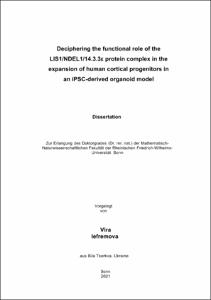Iefremova, Vira: Deciphering the functional role of the LIS1/NDEL1/14.3.3ε protein complex in the expansion of human cortical progenitors in an iPSC-derived organoid model. - Bonn, 2021. - Dissertation, Rheinische Friedrich-Wilhelms-Universität Bonn.
Online-Ausgabe in bonndoc: https://nbn-resolving.org/urn:nbn:de:hbz:5-62915
Online-Ausgabe in bonndoc: https://nbn-resolving.org/urn:nbn:de:hbz:5-62915
@phdthesis{handle:20.500.11811/9230,
urn: https://nbn-resolving.org/urn:nbn:de:hbz:5-62915,
author = {{Vira Iefremova}},
title = {Deciphering the functional role of the LIS1/NDEL1/14.3.3ε protein complex in the expansion of human cortical progenitors in an iPSC-derived organoid model},
school = {Rheinische Friedrich-Wilhelms-Universität Bonn},
year = 2021,
month = jul,
note = {The human brain is an exceptionally complex organ, both structurally and functionally, and represents the most remarkable progress in evolution. The human cortex is a highly organised and extensively folded structure consisting of radially organised layers: gyri and sulci. For many years, transgenic mouse models were used to study gene function in the developing cortex. Recently, it was suggested that human brain development could also be modelled in vitro using the capacity of pluripotent stem cells (PSCs) to self-organise into so-called brain organoids. They contain different cell types that organise in a spatially similar way to the developing human brain and accurately recapitulate developmental gene expression patterns. This study focuses on investigating the functional role of the LIS1 gene during human cortical development. LIS1 and its interactive partners, NDEL1 and 14.3.3e, have been cited as crucial for neuronal migration and cortical layer formation and were recently demonstrated to have a role in the expansion of cortical progenitors. Moreover, heterozygous deletions or mutations in LIS1 constitute the most common cause of lissencephaly. We established a standardised induced PSC-derived cortical organoid model to decipher the functional role of the LIS1/NDEL1/14.3.3e protein complex during human cortical development. To that end, we reprogrammed fibroblasts from patients suffering from haploinsufficiency of chromosome 17p13.3, which involves the genes encoding LIS1 and 14.3.3e, and differentiate them into cortical cultures. We analysed proliferation and neurogenesis on morphological, biochemical, and molecular levels, and demonstrated that patientderived organoids show a significant size reduction, resulting from a shift in ventricular zone radial glial cells from symmetric to asymmetric mode of cell division. This was associated with alterations in microtubule networks and the disruption of cortical niche architecture, leading to a non-cell-autonomous disturbance in the Ncadherin/ß-catenin signalling axis. Reinstallation of β-catenin signalling resulted in a return to symmetric cell division and rescued growth deficits. We provided a novel experimental model to analyse the functional roles of LIS1 and 14.3.3e during human cortical progenitor expansion. Significantly, our data highlights a new role for these proteins in maintaining the cortical niche and suggests that organoids may serve as a useful model for assessing aspects of early cortical development, such as progenitor cell proliferation, cell cycle dynamics, and neurogenesis.},
url = {https://hdl.handle.net/20.500.11811/9230}
}
urn: https://nbn-resolving.org/urn:nbn:de:hbz:5-62915,
author = {{Vira Iefremova}},
title = {Deciphering the functional role of the LIS1/NDEL1/14.3.3ε protein complex in the expansion of human cortical progenitors in an iPSC-derived organoid model},
school = {Rheinische Friedrich-Wilhelms-Universität Bonn},
year = 2021,
month = jul,
note = {The human brain is an exceptionally complex organ, both structurally and functionally, and represents the most remarkable progress in evolution. The human cortex is a highly organised and extensively folded structure consisting of radially organised layers: gyri and sulci. For many years, transgenic mouse models were used to study gene function in the developing cortex. Recently, it was suggested that human brain development could also be modelled in vitro using the capacity of pluripotent stem cells (PSCs) to self-organise into so-called brain organoids. They contain different cell types that organise in a spatially similar way to the developing human brain and accurately recapitulate developmental gene expression patterns. This study focuses on investigating the functional role of the LIS1 gene during human cortical development. LIS1 and its interactive partners, NDEL1 and 14.3.3e, have been cited as crucial for neuronal migration and cortical layer formation and were recently demonstrated to have a role in the expansion of cortical progenitors. Moreover, heterozygous deletions or mutations in LIS1 constitute the most common cause of lissencephaly. We established a standardised induced PSC-derived cortical organoid model to decipher the functional role of the LIS1/NDEL1/14.3.3e protein complex during human cortical development. To that end, we reprogrammed fibroblasts from patients suffering from haploinsufficiency of chromosome 17p13.3, which involves the genes encoding LIS1 and 14.3.3e, and differentiate them into cortical cultures. We analysed proliferation and neurogenesis on morphological, biochemical, and molecular levels, and demonstrated that patientderived organoids show a significant size reduction, resulting from a shift in ventricular zone radial glial cells from symmetric to asymmetric mode of cell division. This was associated with alterations in microtubule networks and the disruption of cortical niche architecture, leading to a non-cell-autonomous disturbance in the Ncadherin/ß-catenin signalling axis. Reinstallation of β-catenin signalling resulted in a return to symmetric cell division and rescued growth deficits. We provided a novel experimental model to analyse the functional roles of LIS1 and 14.3.3e during human cortical progenitor expansion. Significantly, our data highlights a new role for these proteins in maintaining the cortical niche and suggests that organoids may serve as a useful model for assessing aspects of early cortical development, such as progenitor cell proliferation, cell cycle dynamics, and neurogenesis.},
url = {https://hdl.handle.net/20.500.11811/9230}
}






